Review: Microsoft Band 2 - more polished but nowhere near perfect... yet
Score:
82%
In a crowded marketplace, it's always good to carve out a niche - and this is what Microsoft did in the wearables space with the original Band, reviewed here. The idea was to do a lot more than a humble 'fitness band', yet stop short of a full smartwatch. As a result, the Band could be a big aid to your life while keeping a multi-day battery life. It was clunky though - and now we have the Band 2, in theory more comfortable, more durable and better in every way. We're well away from 'prototype' territory this time round, and it remains the smartest thing you can hook up to a Windows Phone, in particular...
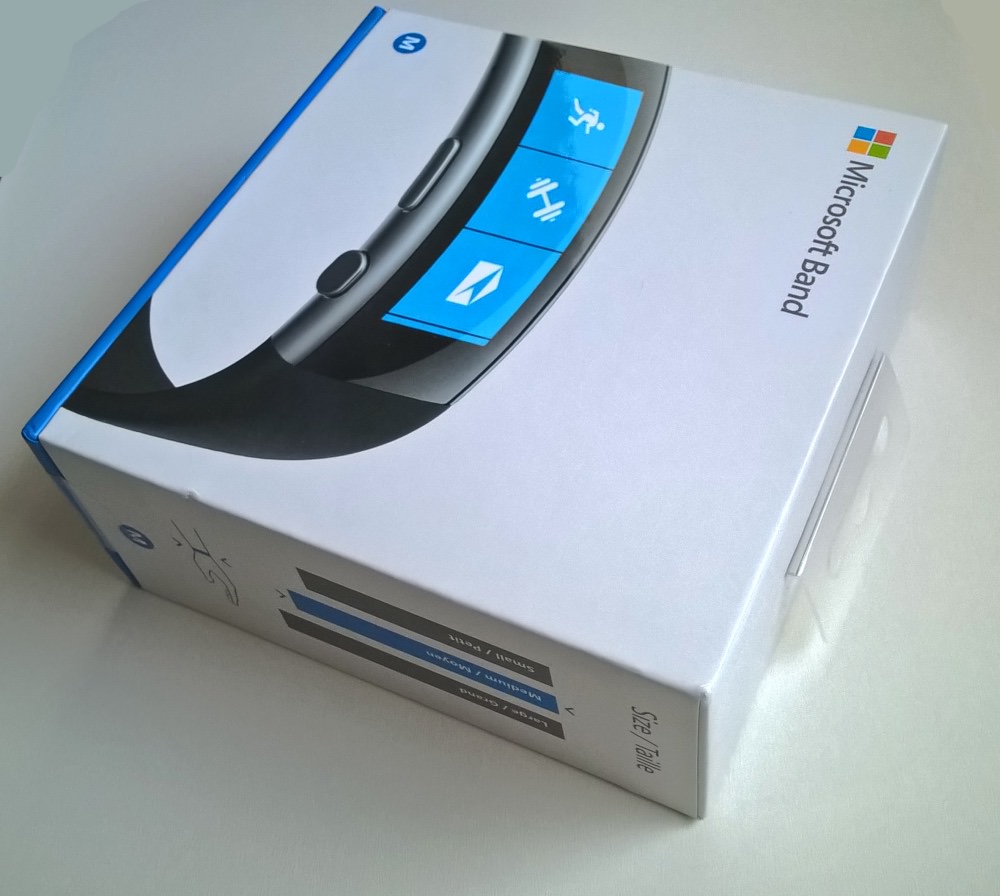
You see, as with the original Band, this accessory is uniquely important to the world of Windows Phone and Windows 10 Mobile in that it's the only thing approaching a smartwatch that works with the platform(s). Yes, various 'dumb' fitness bands can be hooked up, but even the relatively low tech Pebble smartwatches don't hook up to 'our' OS. The Band, being Microsoft through and through, hooks up best with Windows Phone, and provides a large subset of traditional smartwatch functions (notifications, voice assistance, email checking, weather forecasts, and so on).
Therefore, whereas other Band 2 reviews around the web (from USA reviewers, who got the accessory a month ago) have concentrated on the fitness aspects, on the sensors, and looking at integration with Android and iOS, my review will be just as much (if not more) about functioning as a highly-sensored smart accessory for a Windows Phone 8.1 or Windows 10 Mobile smartphone - I was using a Lumia 830 with the latter OS loaded, but it should work just as well with anything else in the Lumia family.
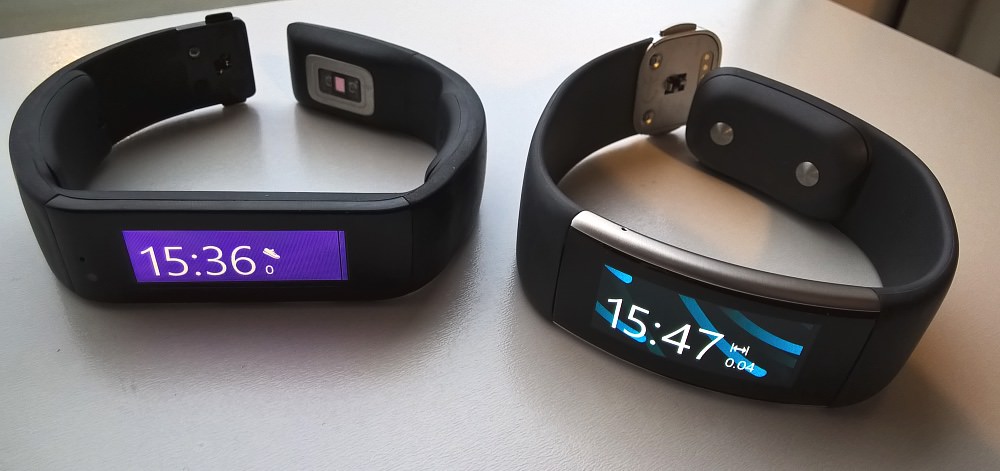
Most of my concerns about the original Microsoft Band were in the form factor and hardware choices made, yet tempered by the realisation that the accessory was a 'prototype' and aimed as much at developers as at consumers. Criticisms included:
- The narrow, flat display that scratched oh so easily
- The chunky strap sides (including twin cell batteries)
- The complete lack of waterproofing
Happily, the Band 2 addresses all of these. The display (now OLED for extra vibrancy and power saving) is both wider/higher (an extra 22 pixels, taking it up to 320 x 128 at 32 x 12.8mm) and nicely curved, following wrist contours better (though the accessory still qualifies as 'chunky'). Steel surrounds look great either side of the glass, which is now full Corning Gorilla Glass 3, so no more scratching worries - phew!

The main left/right strap sections still have loads of wires inside(!) and are still substantial, but they're a lot thinner and more flexible than on the original Band, as you can see in the photos here. There's now just the one battery and it's inside the bottom half of the clasp, with the top half also being steel and eminently premium.
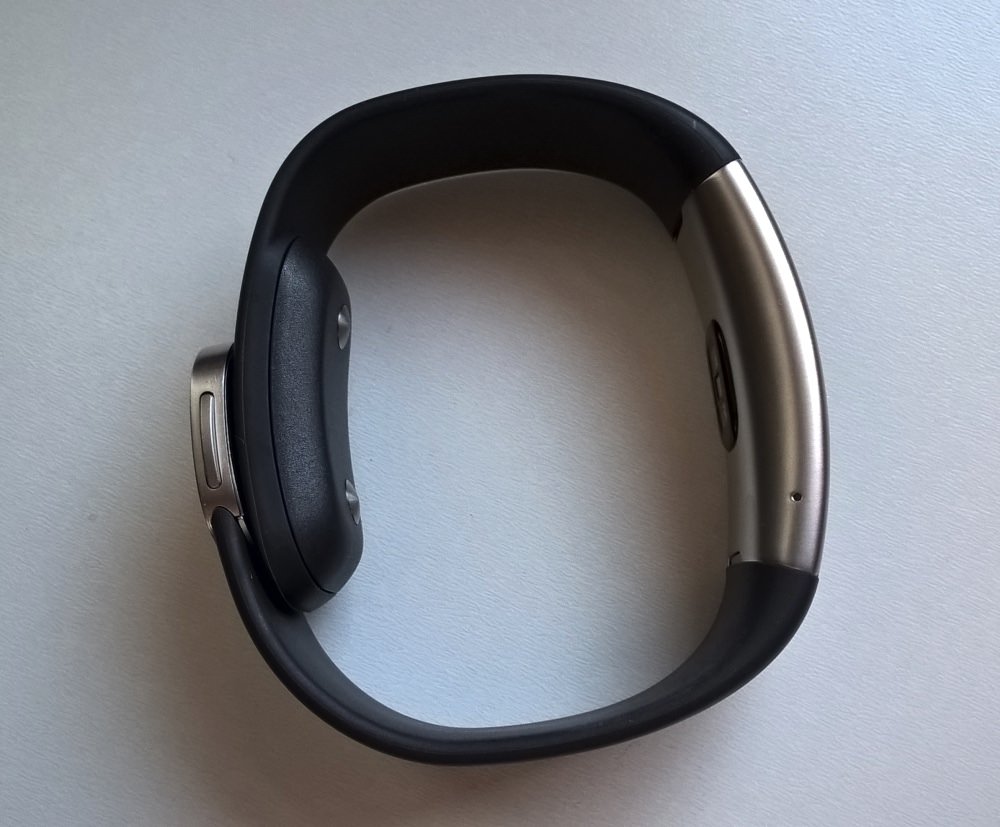
All the black sections are 'thermal plastic elastomer silicone vulcanate', i.e. tough, rubberised plastic, as in the original, and I really like this feel and finish. I was reviewing the 'Medium' size of band and found that I had several 'stops' on the clasp to spare at either end of its travel - I'd suggest only going for the small or large size if you know you have a particularly slender or thick wrist.
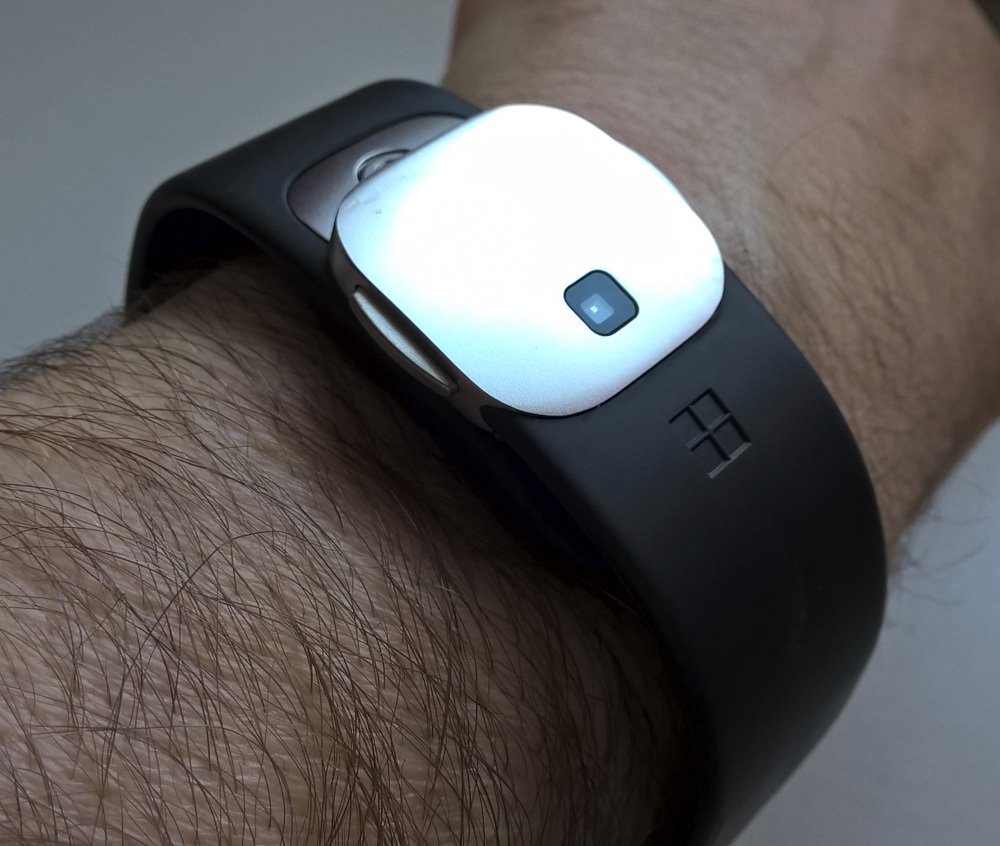
The steel clasp seemed manly and 'techy' to me. I did get 'What on earth is that, it looks like you've just escaped from prison and you're still wearing the wrist tag!' from my wife and daughter though.... Philistines!
The waterproofing does seemed to have been beefed up too - or at least made slightly higher profile in the Band 2's marketing. The same nominal 'IP67' rating is given, meaning that it can stand temporary immersion in water at a depth of 1 meter for 30 minutes, in theory. With the prototype-ish original, I took this with a grain of salt, but I believe it in the Band 2's case. In practice, this means that you can drop it in the bath or sink or sea (etc.) and it's not the end of the world - pluck it out and it'll be fine. Moreover, it may also be fine to wear in a shower, as long as you're careful not to subject the Band 2 to full direct water pressure. But no more than this and it seems that it's sensible to remove it if you know you're going to get seriously wet. And not being able to use the Band 2 to track swimming is a shame, since that's a popular form of exercise and terrifically good for the whole body - yet will count for nothing in Microsoft's eyes if your Band is back in the locker room.

The Band 2 has the full complement of sensors from the original:
- optical heart rate sensor (behind the main display this time)
- 3-axis accelerometer (ditto)
- gyrometer (ditto)
- GPS (the chip is obviously on the main PCB behind the display, with the antenna wire snaking around one of the straps, probably the one to the left of the display, to place it on 'top' when the Band 2 is worn in recommended fashion by a right-hander)
- ambient light sensor (embedded in the display, I suspect)
- skin temperature sensor
- UV sensor (on the outside of the steel clasp)
- galvanic skin response sensor (two contact points on the inside of the clasp)
Plus one extra sensor, buried inside the main module, a barometer, useful (in the future) for feedback to hiking and weather applications but used here to track - in theory - staircases climbed. I kid you not, the idea is to know how many floors you've climbed using the differences in atmospheric pressure. This doesn't sound like it will work and it doesn't. As part of this review, I just went up and down the same floor of stairs ten times and the stair counter stat remains on - ahem - zero. Ah well, it was a nice idea and maybe it works on industrial scale office staircases, which tend to be at least 50% higher. I did note that when exercising 'on the flat', at home (treadmill), the elevation varied +/-10m, which is about the margin of error I would expect - and certainly explains why the staircase counting is unreliable!
Not all the sensors are on all the time, of course - that's the way to a drained battery. The sensors are powered up periodically or when needed - especially the GPS, which is an option when setting off on planned exercise, should you particularly want to track where you've been (e.g. when hiking over unfamiliar territory) - it's best to say 'No' to this when asked if you're re-treading familiar exercise territory. You'll save a lot of power as a result. And GPS is the difference between being out of power at the end of the day (if you've been hiking, running or cycling for a few hours) and enjoying two days (or so) on a charge.
In my (personal) case, 99% of my exercise is either around streets and paths that I know or, when the weather is bad, on my treadmill, where (obviously) I'm not moving on the Earth's surface, so again GPS is pointless. But I can see how it might be very useful for hill walkers and mountain bikers, for example.
The interface remains much the same as on the original band, though the taller screen make quite a difference in terms of finger-friendliness and in how much of notifications/emails/news (etc.) can be seen on screen at once. Moreover the use of an OLED display immediately adds impact in terms of clarity and colours - the whites 'glow' and any background colours and textures are attractively warm. Add in the more organic, gentle curvature, and 'softer' control buttons on the bottom edge (i.e. they respond with a much lighter press) and the overall effect is of a much more refined product, one that you can actually enjoy using. Unlike the original, which always felt hard, unyielding and as if you were fighting the device and its interface most of the time.
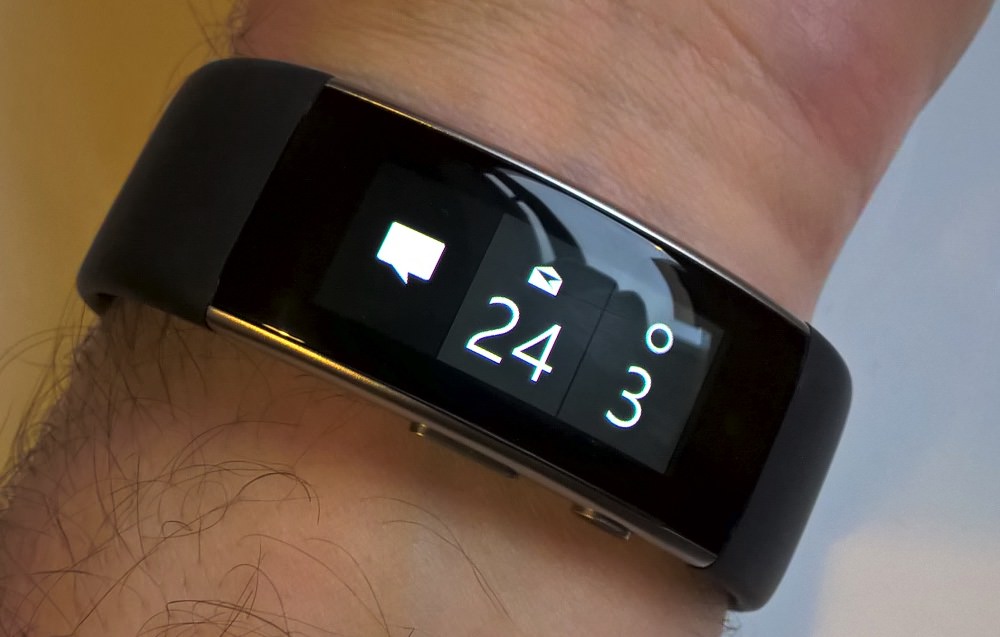
The new 'rotate on' time display works brilliantly, using the accelerometer and gyrometer as inputs to show both date and time as you swivel your wrist a little. You then press the main control button to bring up the full interface and it's then a case of dragging to the right to see Bluetooth, power and heart rate sensor status, or left to work through the live tiles for up to thirteen mini-applications, presented three at a time. In each case, tap on the icon to see more about any new information (e.g. 3 new emails, 2 new Cortana advisories) and drill down into viewing (or at least previewing) the appropriate content.

Managing which mini-applications are included, as well as their order, is something that the companion Microsoft Health application handles, back over on your Windows Phone. This approach works pretty well and saves too much fiddling with settings on the tiny screen of the Band 2, though as every communication with the phone happens over a relatively slow Bluetooth connection, a huge amount of some patience is inevitably required.
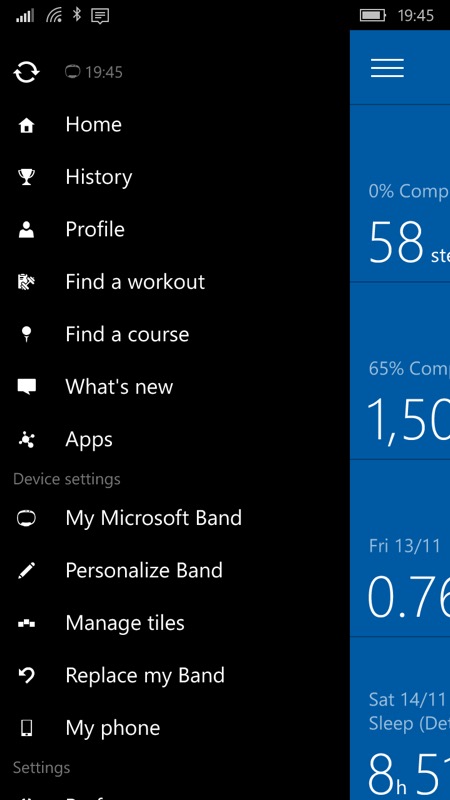
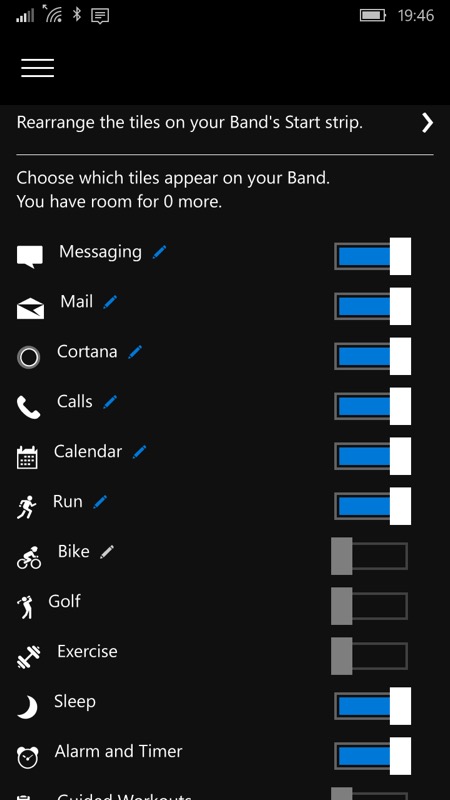
Managing the Band 2 from the Microsoft Health application on the phone: the hamburger menu of functions and the selection of the 13 applications/tiles you want to see on your Band 2 (and you get the chance to reorder them too - see the separate sub-pane linked at the top of the screen.
The clasp mechanism is much wider than the originals, and striking in appearance, but polished steel never grows old and in any case the clasp is also functioning as host for at least two of the Band 2's sensors and it also contains the main battery. Plus the underside of the top of the clasp doubles in latching to the charging cradle - and really securely, so once this is attached then charging can't be interrupted by knocking it accidentally.

All this does add complexity to the internal wiring loom, but the strap sides are so heavy duty that I don't have any long term reliability worries.
The interface is graphically simple enough that the paltry 64MB/ARM Cortex M4 MCU combination with the proprietary OS have no problems in terms of performance. Although the UI does seem smoother than the original's, it also seems to draw more power (or that could be the extra sensor). Either way, I was getting less than 48 hours on a charge with light use, i.e. without explicit workouts or runs/rides. With serious exercise thrown in, the Band 2 is currently a 'charge every night' accessory.
This isn't a showstopper for many, since you'll be charging your phone as well anyway, though it does prevent regular sleep tracking (since the accessory will be dangling off the end of a USB cord rather than on your wrist). Charging only takes half an hour when plugged into a 1A (or more) charger, mind you, so if you're organised enough then you can simply factor in a stint on the charger elsewhere in your daily routine and still enjoy health tracking through the night.
You'll possibly wake up healthier too, thanks to a new 'Smart Alarm' feature, monitoring your vital signs and waking you while in light (sleep) rather than deep sleep. This can be any time up to half an hour before your desired alarm time but in theory the waking up process will be less stressful. In theory. I think I'd rather have the extra half hour and sleep technology be damned!
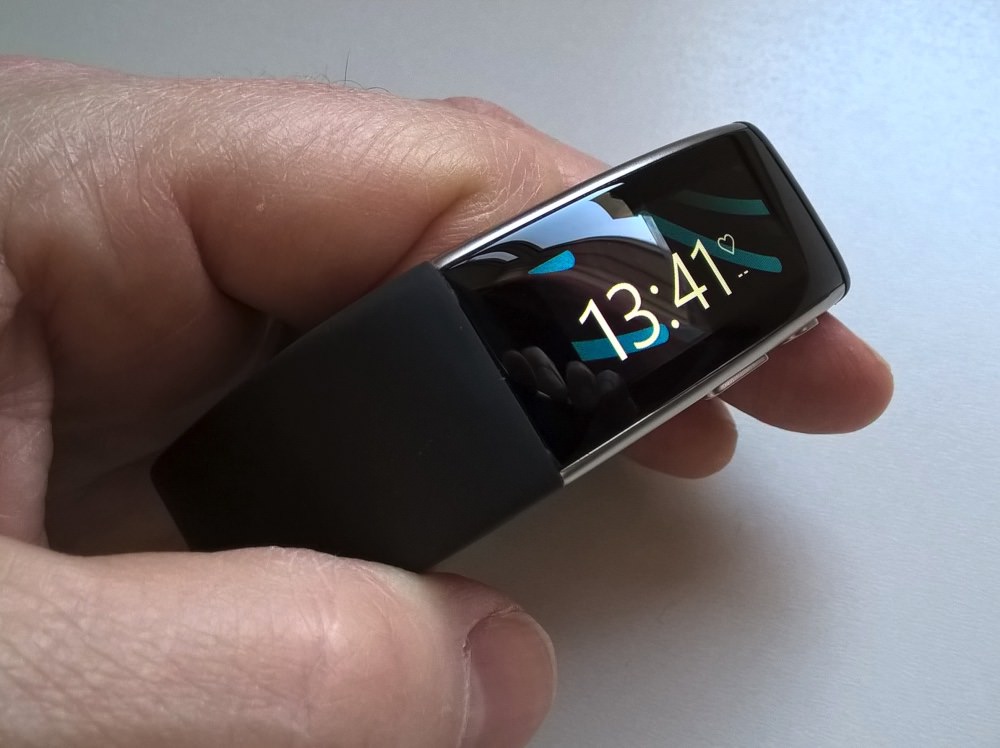
Microsoft added a Golf application/tile a while back, and this is here on the Band 2, of course, along with other newcomers Golds Gym Inspirations (snippets of inspirational texts), AP News, Xbox Wire and a load of USA-focussed Bing Sports feeds, all available in the 'Go to tile gallery' mini-Store, accessed from the Microsoft Health application.
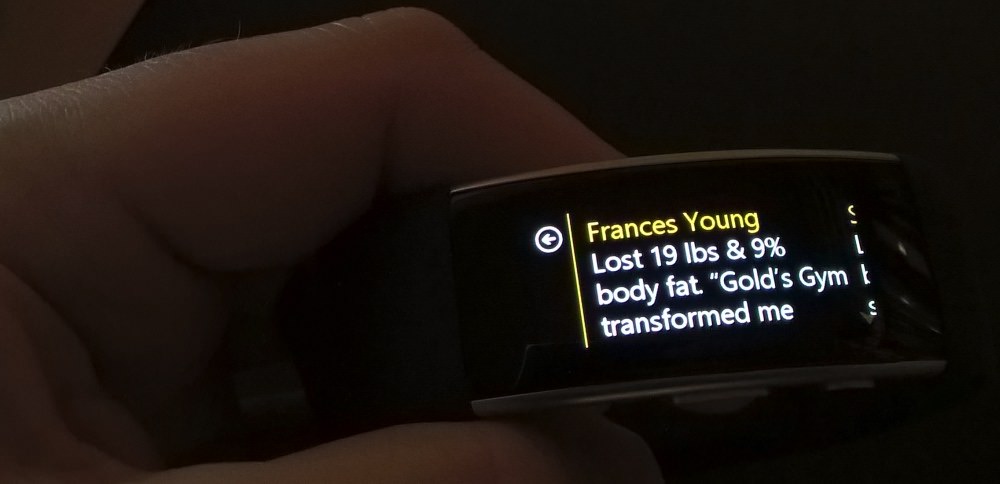

Two of the newer (optional, via download) Band tiles, the former rather worthless text quotes from a gym franchise, the latter potentially useful sports headlines for particular USA (American Football) teams...
The Microsoft Health Dashboard (on the web) gets better and better, but does require lots of data if you want to get anything meaningful from it. Which means that I can't really pass judgment until I've had all this in use for a few months - expect a 'How I collapsed in a heap got fitter thanks to Microsoft Health' story in due course. 'VO2 max' (your body's capacity to transport and use oxygen during exercise) is a new calculation, though it a) is only an estimate and b) only kicks in after you've completed five qualifying workouts - so again I'll have to report on this in due course.


Typical output after exercise (note the new elevation gain/loss section); (right) typical - and excellent - sleep analysis!
Microsoft Health on the phone remains frustrating - I've lost count of the number of times I've cranked it up to show off the Band concept to someone (usually to show the excellent sleep analysis - 'deep' vs 'light', etc.) and then had to waffle for 30 seconds to distract them from the eternity the application takes to crank itself into action and then sync with the Band. The application itself needs some optimisation and the Band communication needs extreme optimisation - we're only talking about sending a few hundred floating point numbers between two adjacent devices - this is 2015 and I fail to see why this should take half a minute, even over Bluetooth (which can cope with high quality audio, after all) data rates.
Plus syncing is unreliable. The Microsoft Health screen shown above, right, correctly shows last night's sleep, but for some unknown reason the Band took many hours to get round to thinking about syncing this data over. I assumed that the sleep (detected, in this case, I wanted to try out the automatic sleep detection) simply hadn't been registered. Yet it suddenly 'appeared' at tea-time. There's definitely a lot of work to do in terms of app/Band communication.
Talking of music, storing this on the Band 2 and streaming from the accessory is one area that Microsoft has pointedly avoided. Which is fair enough - storage requirements, getting the music on in the first place, and other possible pitfalls - but why can't a simple music toggle tile/control be added? I'm guessing that this might not be fully cross-platform compatible, but for Microsoft's own Windows Phone/Windows 10 Mobile, at least, why can't we have a set of simple playback controls for Groove Music? The audio itself would be streaming from the phone (and possibly sourced from OneDrive), but all the Microsoft Band would have to do is control play/pause/back/forwards. Seems like childs-play to me and its omission is disappointing. Every other smartwatch in existence has some form of music control, by the way, so it's Microsoft that's bucking the trend here.
Comfort remains an issue for me. After 24 hours on a wrist, it's starting to get uncomfortable, almost as much as the original Band, if I'm honest. The skin gets red and clammy and my solution is to transfer the Band 2 to my other wrist for a bit. It's not ideal and I'd welcome data points from others. In fairness, the need for the Band to be in constant, relatively firm contact with the wrist in several places means that some discomfort is probably unavoidable.
Value for money is tricky to evaluate. In the UK it's £200 including VAT, which is definitely on the pricey side, given the lack of 'smarts', e.g. compared to what you can get in the Android Wear world. Now, I appreciate where the Band 2 is coming from, I appreciate what Microsoft is aiming for in terms of 'health+' rather than trying to replicate too many smartphone functions, but I'd still like to have seen a lower price (£150 feels about right for a maximum), true multi-day battery life, and basic music control.
The price will come down, of course, and the other two are in the realm of software updates*, so let's stay optimistic. In the meantime, the Microsoft Band remains the most powerful 'smart' wearable that works with Windows Phone and Windows 10 Mobile, so if you need updates on your wrist then it's just about the only game in town. If you're not sure about the concept though, seek out the original, now being sold off in bargain bins around the world at a third the price, and have a play with that first.
* Band updates are trivial to apply and take only a couple of minutes - once such update was ready to apply after taking the Band 2 out of the box.
Reviewed by Steve Litchfield at
